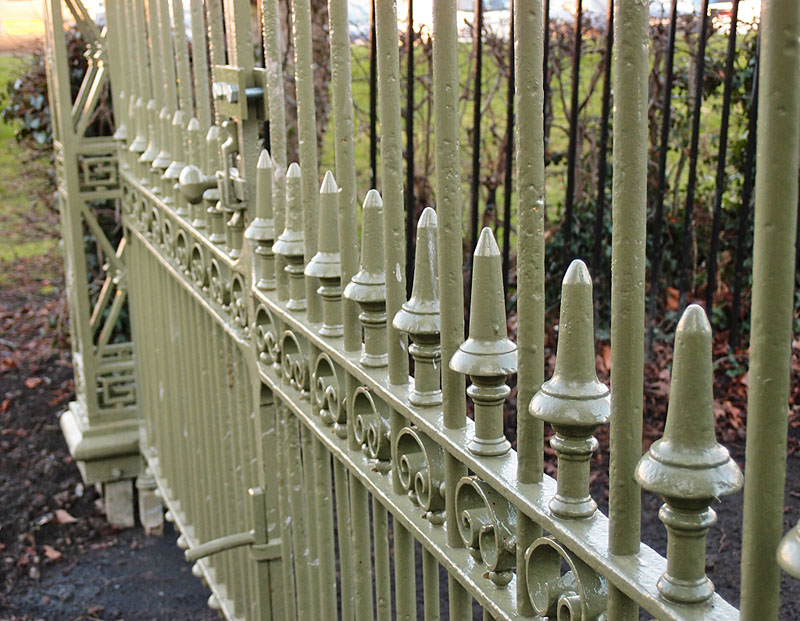
Bridge Lane gates, 2017
Long ago, way back in the mists of time — 2004 — I took a photo of some rusty old gates on Bridge Lane, the last photo on a fairly long wander through town. I don’t think the photo appeared in one of my York Walks pages on York Stories at the time, but many years on I got around to posting a page on the gates and gateposts, still there then, still rusting: Walker foundry relic on ‘Asylum Lane’ (2012).
Since then, very recently, they’ve been restored, so a revisit seems appropriate. I also have some queries about the land behind them.
But first, these gates.
In August 2004 they looked like this:
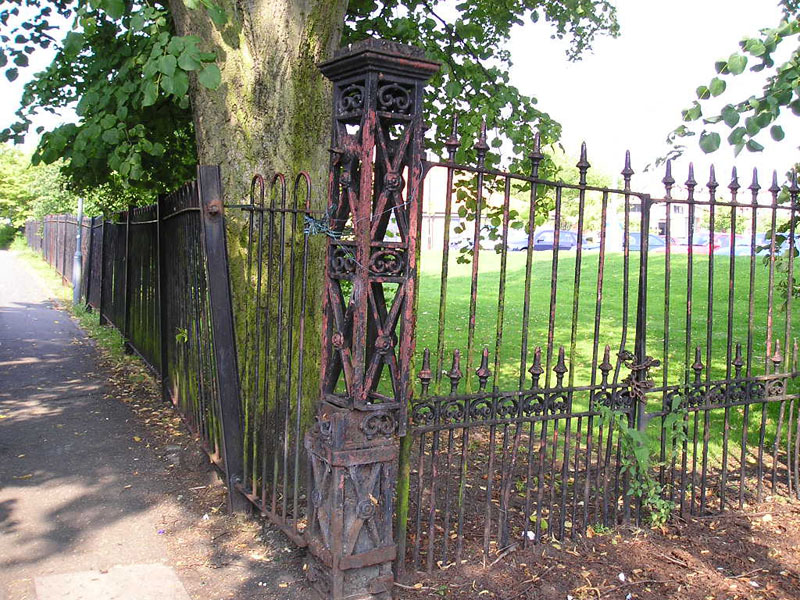
Bridge Lane gates, August 2004
In November 2012, like this:
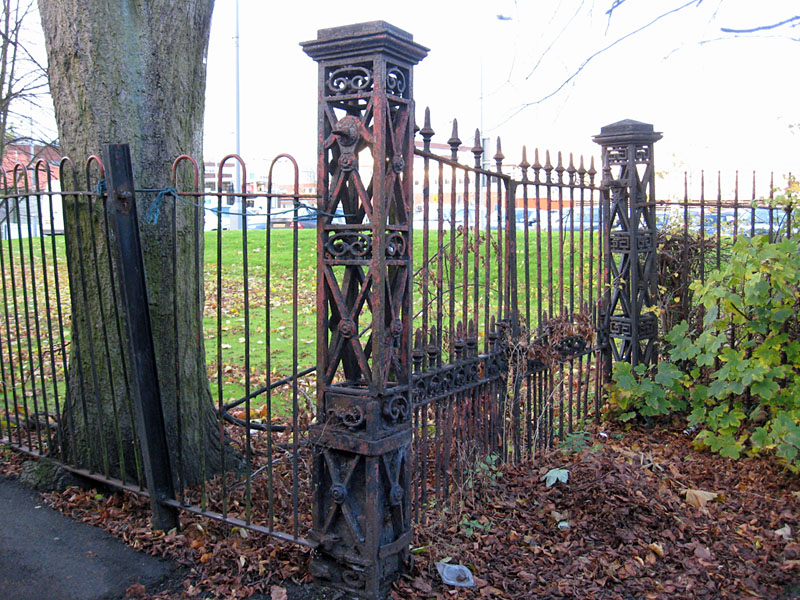
Bridge Lane gates, Nov 2012
And now, in 2017, like this:

Bridge Lane gates, 2017
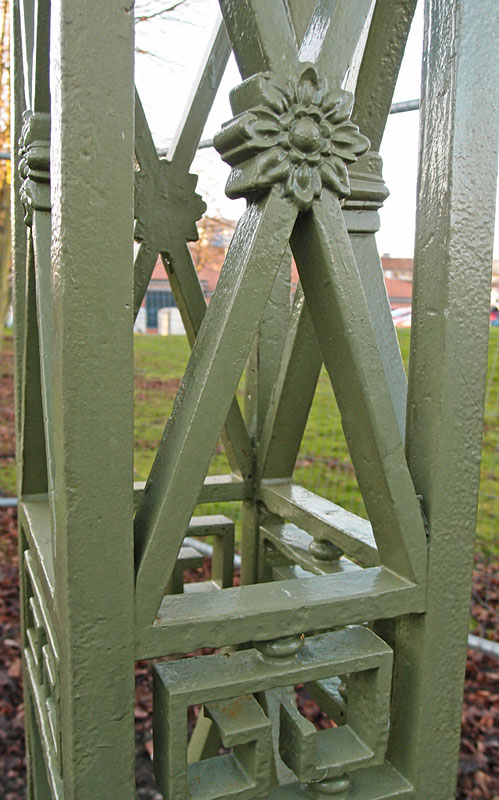

As previously mentioned, in a walk along Bridge Lane back in October, I’d noticed their removal and some helpful signs put up by York Civic Trust explaining that they were being restored and would be put back in due course.
It’s more obvious now they’re restored and repainted that the gateposts don’t match — they’re different designs if you look at the details of the scrolls and the flowers in the photos above. There’s probably a story behind this, but I don’t know what it is. Normally, with a pair of gateposts, you’d expect them to match one another.
More obvious is the change of colour. Personally I find the colour very pleasing, and think it makes sense to draw attention to the restoration by choosing something other than the more usual black.
Also interesting are the maker’s plates, which I hadn’t noticed before. They’re now clearly visible on the gates between the columns of the gateposts, but they don’t say ‘Walker':
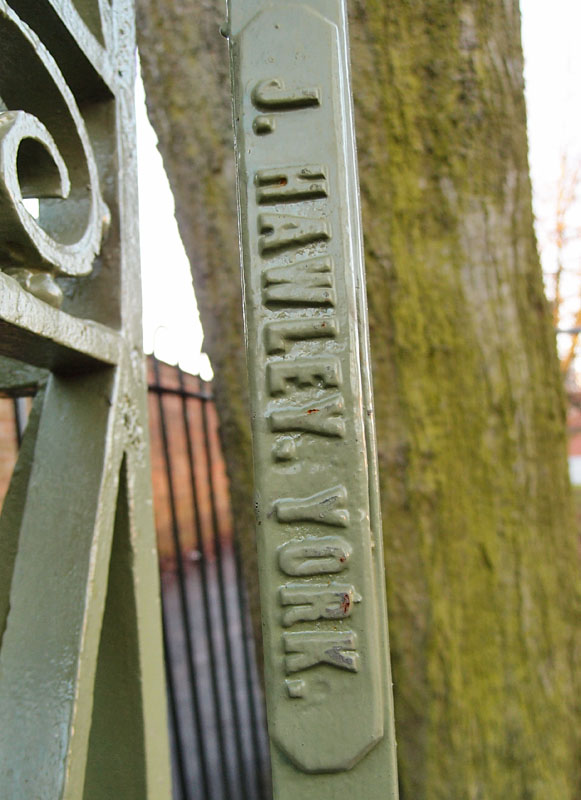
Nick Beilby, York Civic Trust’s Project Manager, confirmed that they were there before:
The gates were cast by Hawley’s who were brass founders on Walmgate, close neighbours of Walkers. It is likely that they carried out the work on a sub contract basis to Walkers. The ‘Hawley’ plates were found when we blast cleaned the ironwork.
The ironwork was restored by Barker and Patterson (Hull).
Leading to … playing fields, and ridge and furrow?
The gates don’t open now, but let’s imagine we’re pushing them open onto the land behind, before it was built on, when it was fields, and later, playing fields.
The land behind the gates is now occupied by the city’s hospital, and has been since the mid 1970s. But as previously mentioned on the earlier page these fine gates used to lead to playing fields, and two comments on previous pages, from Stephen and David, shared memories of this area at those times, which many other readers will remember:
At this time [late 1960s] there was a mature hedge on the opposite side of the lane to the wall, and beyond this a large expanse of grassland where the hospital now stands. I used to play football there with friends, and also remember York City would use it for training. I also remember watching a school rugby game adjacent to Wiggington Road between my school Lowfields, and Park Grove, who used the area as playing fields. There was a rudimentary changing hut next to the ornate gates mentioned in your article. I seem to remember it was oval in shape, and built of Asbestos sheets, rather like the garages of the forties and fifties.
– David Bower
A map available on old-maps.co.uk, dating from 1937, suggests that at that time the large area of land here was divided into several distinct areas of playing fields, with a smaller school sports ground to the right of these gates, a larger sports ground on what is now the southern part of the hospital grounds, and a separate cricket pitch to the northern area. This would be from around the time Stephen remembers it, I think.
A 1961 map (from nearer the time David describes) shows the school sports ground apparently absorbed into the main sports ground, with a small area marked as ‘playground’. There’s still the cricket ground to the north, and a bowling green and tennis courts also marked in this area. There’s also the rugby ground to the east (since relocated, site filled with housing), and the York City ground (still there) to the west.
Quite the ‘Sports Quarter’ back then, apparently.
But I’ve also read, in several reliable sources, that remnants of ridge and furrow were visible on this particular piece of land, into the 20th century. Bridge Lane was formerly known as Asylum Lane:
Formerly in Clifton, the largest surviving block of broad ridges within the city is on playing fields N. of Asylum Lane (around 60205300) measuring at least 300 by 200 yds. This clay area, at one time Laithe Close, has slightly sinuous ridges, 30 ft. wide and 1 ft. high. One parcel of ridges is aligned E.N.E. and another N.W.
– (source)
I’m wondering how that fitted with playing fields, which are traditionally flat. Presumably by the 20th century it was just a few bits around the edges, or perhaps football players had to battle with balls falling into furrows?
More information
Historic Environment Record, a fascinating resource, local historic features mapped and described. This link may work to take you to the relevant point (though you’ll need to zoom in). The brown lines denote the ridge and furrow. Clicking on the relevant area takes you to the Heritage Gateway pages: see this link and also this link which includes the brief explanation ‘Ridge and furrow seen as earthworks on 1936 air photographs’.
. . . . .
If you’d like to be kept informed of new additions to this site please join the mailing list.
Please also have a look at supporting this site in 2017.





There is an interesting image of the corner of Wigginton Road and Bridge (Asylum) Lane taken in the early 1900’s on the Explore York Libraries & Archives – York Images website. Key in Wigginton Road, and it is the second image displayed. Zooming in on the left hand bottom corner will show the railings, and a corner post matching the restored gateposts from further down the lane. It makes an interesting comparison.
Really good to be reminded of this photo David, thank you. Back in November 2013 I received an email with this photo and others attached, part of the Fairbank archive, now owned by Arup. I included a few of them (see http://yorkstories.co.uk/tag/fairbank-archive/) but not all, and the one you mentioned provoked some discussion as on the York Images collection the caption was a bit confusing regarding which way we were looking (towards the city or away from it).
I have the original with the handwritten caption – well, a scan of it. Maybe one for a later page. Thanks again for reminding me of it.
Dear Lisa, An important element of York Civic Trusts project to restore the above gates was to research the history including peoples memories of the gates. One such memory is the following from Tom Bardy who was an exceptional sportsman and athlete and attended Archbishop Holgates Grammar School from 1948 to 1955.
” I know that for me going through these represented a release from the confines of the classroom,relief of Latin declensions and the intricacies of trigonometry and Pythagoras theorem. I really looked forward to my games afternoons playing rugby on this field even though we often had to trudge back to school through the streets covered in mud and soaking wet, and often the showers were cold.”
As an aside Mr Bardy was well known to many of us who in the 1960s and 70s attended Nunthorpe Grammar School where he taught PE, Games,Maths and Biology and was very highly thought of by his pupils.
Really nice to have this evocative account and recollection of this particular place Nick, thank you for adding it,
Lisa
Lisa
In the late 1940’s early 1950’s my mother was secretary and a player at York Womens Hockey Club and when she was playing on a Saturday my father used to take me as a toddler to watch York Rugby League just across the road.
In the mid to late 1950’s New Earswick Cub scouts for whom I was goalie played all there ‘home’ matches on the first pitch next to Asylum Lane.
In the 1960’s as a player for Nunthorpe Grammar School rugby team we would visit the playing fields to play Archbishop Holgates as all their home matches were played here.
Also, on the rare occasions that we would lower ourselves and go to watch York City, everyone from our side of York would park around the rugby ground, walk down Asylum Lane and over the wooden bridge to Bootham Crescent. As a child one always wondered how strong the bridge was as hundreds of people stomped over it!
Then they built the hospital and my wife went to work there until she retired. And now I am visiting every fortnight for treatment. Keep up the good work Lisa
John Sims
I came across this site while browsing and found Tom Bardy`s name. He is my cousin but I have not heard from him or anything about him in decades – too much moving around.
Do you have any information about him? Thank you.
Margaret,
I attended Nunthorpe Grammar School from 1967-1972 and Tom Bardy was my Form Master when I was in the first form. He subsequently taught me for PE , Games, Maths and Biology and was greatly respected by us all. I spoke to Tom today and he asked if you had a sister called Janet. Feel free to call me on 07948418774.
Nick Beilby.
I tried your phone but left a somewhat garbled message so will do it this way too. Yes, I had a sister called Janet, but I am distressed to say that she passed away in 2003. I was at Mill Mount school 1945/52 but have been in Canada since 1969. However, no doubt about it,Tom is my cousin. My last trip to York was in 2016 to see the Mystery Plays in the Minster.
Hi Nick and Margaret, I hope you’ve been able to contact one another on the details provided, let me know if you’d like me to remove your personal phone numbers/email addresses from the comments,
Lisa
http://www.yorkstories.co.uk
(update, 25 Nov: thanks both for your messages, have edited comment info as agreed)
Hi Lisa,
Thank you so much for the suggestion. Yes, I would like my phone number and email removing from the site. In spite of visiting York from time to time over many years, I still look upon it as my “home town” and as New Earswick as my “village”.
Margaret